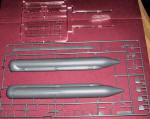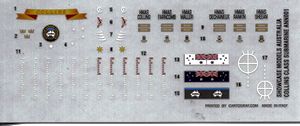
Showcase Models 1/350 HMAS Collins
| KIT #: | ANN001 |
| PRICE: | $30.00 SRP |
| DECALS: | One option |
| REVIEWER: | Scott Van Aken |
| NOTES: | New tool kit |

| HISTORY |
Collins was laid down in February 1990. The two most complex sections of the first submarine were constructed by Kockums' shipyard in Malmo, Sweden, while the other four sections and complete assembly of the submarine occurred at Australian Submarine Corporation's facility in Port Adelaide, South Australia. It was originally planned to construct the first submarine completely overseas, but by the time the tender was awarded, it had been decided to build all six submarines in Australia; the increase in cost by not building the lead ship in the winning designer's home shipyard were believed to be offset by the additional experience provided to Australian industries.
While the bow section of the first boat was being assembled in Sweden, multiple defects in the hull welding were discovered. Different reasons were given by different parties for the problems: the steel alloy used for the hull required different welding techniques to those normally used by Kockums; the Swedish navy always requested partial penetration welds for their submarines, while the RAN wanted full penetration welding but failed to make this clear; delays in delivering the steel plates to Kockums resulted in rushing the work and the resulting drop in quality. It was proposed that the section be kept by Kockums to repair the welds, but it was decided to accept the section as-is and repair the welds at ASC to minimise delays in the project.
The launch of Collins was originally planned for 1994, but was later set for August 1993. The submarine was launched by shiplift on 28 August 1993. Although launched on schedule, she was not complete: the design of the submarine had not been finalised, important internal pipes and fittings had not been installed, the components of the combat system had not been delivered, and some sections of 'hull' were sheets of timber painted black so the submarine would appear complete in photographs of the launching ceremony. Within weeks of the launch, the boat was removed from the water, and it was not until June 1994 that she was completed. Work on the other submarines in the class was delayed by the extra effort put in for Collins to meet her launching date, and by the subsequent work to complete her. The submarines are covered in a skin of anechoic tiles to minimise detection by sonar: Collins was retrofitted with the tiles after the standard sonar signature of the submarine had been established, while the other five boats were covered during construction.
Collins was named for Vice Admiral Sir John Augustine Collins; famous for commanding HMAS Sydney during her Mediterranean deployment in 1940—41, and becoming the first Australian to command a naval squadron in 1944.
| THE KIT |
 For
many of us, modern submarine kits are a great way to relax and build something
nice without having to worry about AMS taking over. Since the idea is to glide
smoothly and silently through the oceans, they are not very parts intensive and
this one is no exception. It is apparently Showcase Models Australia's first
offering and the molding is first rate.
For
many of us, modern submarine kits are a great way to relax and build something
nice without having to worry about AMS taking over. Since the idea is to glide
smoothly and silently through the oceans, they are not very parts intensive and
this one is no exception. It is apparently Showcase Models Australia's first
offering and the molding is first rate.
The two hull halves are split vertically with an upper deck insert. The conning tower is molded in clear plastic so you don't have to sweat installing separate transparencies in it. One simply masks off the clear areas and that is it. Also in clear plastic is the display stand. It is obvious from all the ejector pin marks in the stand pieces (the inside of them) that this was designed to be painted.
The rest of the parts consist of the various bits that fit on the conning tower such as the periscopes and dive planes. The fins are in an X shape and fit into indentations. There is a can looking gizmo on the upper forward decak and what looks like a towed sonar array for the back.
 Instructions
are on the back of the box and the small decal sheet offers either standard
markings or the launch markings which consist of several color banners. I have
really darkened the decal sheet image to try to allow the white bits to be seen.
The markings guide is on the back of the box as well. The sub is basically black
overall with brass prop blades.
Instructions
are on the back of the box and the small decal sheet offers either standard
markings or the launch markings which consist of several color banners. I have
really darkened the decal sheet image to try to allow the white bits to be seen.
The markings guide is on the back of the box as well. The sub is basically black
overall with brass prop blades.
| CONCLUSIONS |
It is very nice to see this kit being released. In fact, it is nice that manufacturers are doing quite a few modern diesel subs and this one makes for a nice addition for those who are concentrating on that aspect of these boats.
| REFERENCES |
http://en.wikipedia.org/wiki/HMAS_Collins
July 2013
Thanks to www.dragonmodelsusa.com for the preview kit. Get yours at your local retailer.
If you would like your product reviewed fairly and fairly quickly, please contact the editor or see other details in the Note to Contributors.